Kepler’s Supernova (SN 1604) is the remnant of a supernova first observed in the constellation Ophiuchus in October 1604. The supernova occurred in the Milky Way galaxy, less than 20,000 light-years from the Sun. It peaked at magnitude -2.25 to -2.5 and could even be seen in daytime.
Kepler’s Supernova is also known as Kepler’s Star, Kepler’s Nova, Kepler’s SNR, SN 1604, or Nova Ophiuchi 1604. It was named after German astronomer Johannes Kepler, one of the first astronomers to observe it. While Kepler did not discover the supernova, he described it in great detail in De Stella Nova in Pede Serpentarii (On the New Star in the Foot of the Serpent Handler), a book written in 1605-06.
SN 1604 was classified as a Type Ia supernova, the type that occurs in binary systems in which at least one of the components is a white dwarf. In these systems, the white dwarf gains mass by pulling gas from the companion star until it reaches the Chandrasekhar limit, the critical mass beyond which its core reaches ignition temperature. Once the core ignites, it triggers a runaway reaction that releases enough energy to produce a supernova event. In the case of Kepler’s Star, astronomers have not identified a surviving central star, which indicates a Type Ia event.
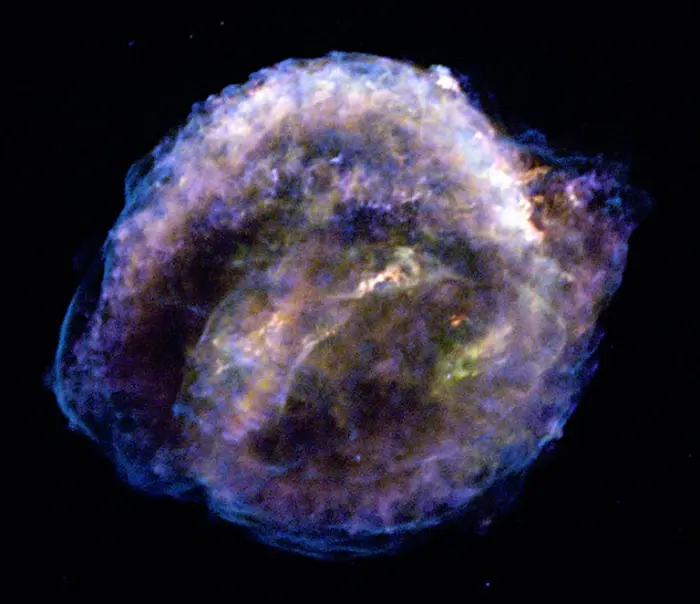
A long Chandra observation of the Kepler supernova remnant provides unprecedented detail of one of the youngest supernovas in the Galaxy. Studying the debris of this stellar remnant helps in the understanding of how a star’s life can end. Red in this image shows material heated by the supernova, while yellow and green depict different elements in the ejecta. Blue represents the highest-energy X-rays and shows a shock front generated by the supernova event. Image credit: Chandra X-ray Observatory, Smithsonian Institution, NASA/CXC/NCSU/S.Reynolds et al.
Kepler’s Supernova reached its peak brightness in the middle of October 1604, when it outshone Jupiter. By November, it was still as bright as the planet. In early January 1605, it slightly dimmed, equalling Antares in brightness. By October 1605, the supernova’s brightness dropped to the fifth magnitude and, by the spring of 1606, it faded below unaided eye visibility.
In visible light, only filaments of the surrounding nebulosity can be seen, but the remnant is a strong source of X-rays and radio emissions. It has a diameter of 4 arcminutes.
The distance of Kepler’s Star is still uncertain, with estimates in the range from 10,000 to 23,000 light-years. Recent estimates place the remnant at 5 ± 1 kiloparsecs away.
Unlike most remnants of Type Ia supernovae, Kepler’s Nova is asymmetrical and contains a bright arc of X-ray emission in its northern portion. Revealed by NASA’s Chandra X-ray Observatory, the arc indicates that the expanding debris from the supernova event is colliding with the dust and gas around the stellar remnant.
The X-ray arc may have been created by a bow shock wave as the central star and its binary companion moved though the interstellar gas and underwent enormous mass loss through a powerful stellar wind. In this case, the Kepler supernova remnant likely lies more than 23,000 light-years away.
The other possible explanation of the X-ray spectrum is that the arc is the product of the ball of debris from the supernova expanding into an interstellar cloud of increasing density. In this instance, the estimated distance of the remnant is 16,000 – 20,000 light-years. These values were obtained in a study published in The Astrophysical Journal in September 2012. The study was authored by Daniel Patnaude from the Smithsonian Astrophysical Observatory in Cambridge, Carles Badenes from University of Pittsburgh in Pittsburgh, Sangwook Park from the University of Texas at Arlington, and Martin Laming from the Naval Research Laboratory in Washington DC.
The presence of the dense gas and the abundance of nitrogen and silicon in the remnant indicate that the progenitor system consisted of a binary pair, a white dwarf and a red giant that had most likely passed through the asymptotic giant branch (AGB). However, the lack of bright stars near the remnant’s centre implies that the companion was not a Sun-like star. Instead, the supernova event may have been triggered by the merger of two white dwarfs.
A 2021 study based on observations with the XMM-Newton satellite was consistent with a previously proposed theory according to which a runaway AGB star moved to the north-northwest and towards us. The study authors found that the northwestern half of the central bar structure was blue-shifted while the southeastern half was red-shifted. This may be the reason why, unlike Tycho’s Supernova, Kepler’s Nova is not symmetrical; the remnant is interacting with a bow-shock shell produced by the interaction of the progenitor’s stellar wind with the interstellar medium.
A 2020 study suggested that the supernova remnant was interacting with a bipolar planetary nebula produced by one or both progenitor stars.
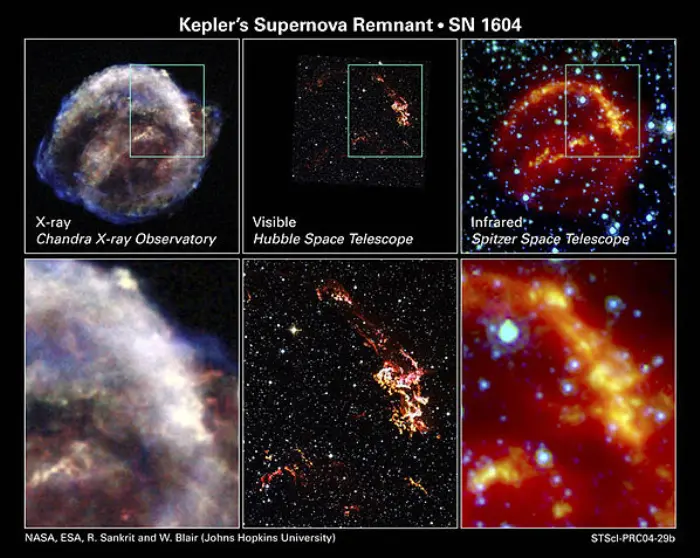
X-ray (Chandra X-ray Observatory), infrared (Spitzer Space Telescope) and visible spectrum (Hubble Space Telescope) views of the remnants of Kepler’s Supernova, image credit: NASA
Facts
Kepler’s Supernova was the last Galactic supernova visible to the unaided eye. Two more recent supernovae were observed in other galaxies. S Andromedae (SN 1885A) occurred in the Andromeda Galaxy and was seen in 1885. Peaking at magnitude 6, it was theoretically visible to the unaided eye. The more recent type II supernova SN 1987A occurred in the Large Magellanic Cloud (LMC) and shone at magnitude 2.9 at its peak. Located in the far southern sky, it was largely invisible to observers in the northern hemisphere.
At its peak, Kepler’s Supernova was brighter than any star in the night sky and could be seen in daytime for more than three weeks. The phenomenon was recorded by astronomers in Europe, China, Korea, and the Arabian Peninsula.
SN 1604 was the second supernova to be seen in a generation, after Tycho’s Supernova (SN 1572) in the constellation Cassiopeia. Named after Danish astronomer Tycho Brahe, SN 1572 was observed in November 1572. It was also a Type Ia supernova. Both supernovae were among the eight historically recorded supernovae visible without binoculars. As one of the prototypical supernova remnants, Kepler’s Supernova is a frequent target of study. It provides scientists with clues about the progenitor star and the processes that lead to Type Ia supernovae.
At the time of discovery, Kepler’s Star was located in the same area of the sky as the planets Mars and Jupiter. Astronomers were observing the planetary conjunction, which they associated with the Star of Bethlehem. Several astronomers and scholars who observed the conjunction on October 8, including the German surgeon Wilhelm Fabry, astronomer Michael Maestlin and physician Helisaeus Roeslin, did not report seeing the remnant. When it did become visible, the supernova appeared less than 2 degrees from Jupiter. On October 9, it became about as bright as Mars.
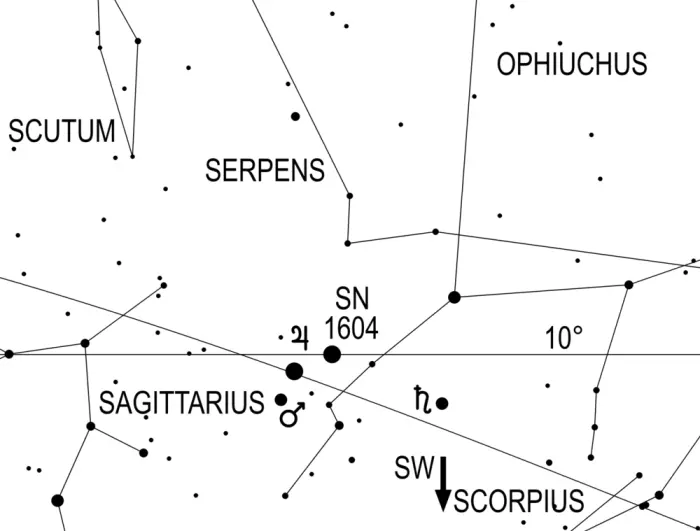
View of the southwestern sky for an observer located on October 9, 1604 at 19:00 CET at a location situated at latitude 50°N and longitude 9°E. On this day, the supernova 1604 was observed for the first time. In the immediate vicinity there were the planets Mars and Jupiter (marked by corresponding symbols), which were in conjunction with each other on the same day. A little westwards Saturn (also marked by a corresponding symbol) could be seen, which Mars passed on 9/27/1604 and Jupiter on 12/19/1603. Mars was 0.8 mag on October 9, 1604, Jupiter -2.0 mag and Saturn 0.6 mag. Supernova 1604 may have been as bright as Jupiter on that day. The star map also includes the ecliptic and a line for the elevation of 10° above the horizon. Image credit: Wikimedia Commons/Zonk43 (CC BY-SA 4.0)
The remnant of the historical supernova SN 1604 was discovered at the Mount Wilson Observatory in California in 1941. At the time, it appeared as a dim nebula with an apparent magnitude of 19. In the March 1943 edition of The Astrophysical Journal, German astronomer Walter Baade showed beyond any doubt that SN 1604 was a Type I supernova based on its light curve.
Kepler’s Supernova was discovered by Italian scholar Lodovico delle Colombe from northern Italy on October 9, 1604. Delle Colombe published a discourse on his discovery (Discourse of Lodovico delle Colombe in which he shows that the Star Newly Appeared in October 1604 is neither a Comet nor a New Star) in 1606. Delle Colombe argued that Kepler’s Supernova was a not a new star but a permanent one that was only occasionally visible. His argument supported the Aristotelian model (the Ptolemaic system), which held that stars were fixed and unchanging.
Johannes Kepler did not begin observing the supernova due to bad weather until October 17, even though he was notified of its appearance by J. Brunowsky in Prague. At the time, Kepler was employed at the imperial court in Prague for Holy Roman Emperor Rudolf II. He tracked the object for a whole year and made meticulous notes, which are included in his book De Stella Nova.
Galileo Galilei, who was a professor at the University of Padua at the time, regarded the object as a new star. A response to Delle Colombe’s discourse, ridiculing his views, was published under the title of Considerations of Alimberto Mauri on Some Passages in the Discourse of Lodovico delle Colombe. Alimberto Mauri was a pseudonym, and the work is widely believed to have been authored by Galileo.
Galileo found that the supernova displayed no parallax and concluded that it lay beyond the Moon. He proposed that it was likely composed of airy material from Earth that was illuminated by reflected sunlight, not unlike Aristotelian comets. Unlike the comets, however, it could rise beyond the Moon.
In response, Delle Colombe published Risposte piacevoli e curiose (Pleasant and curious replies) in 1608, in which he attacked the ideas of Copernicus and associated them with Galilei.
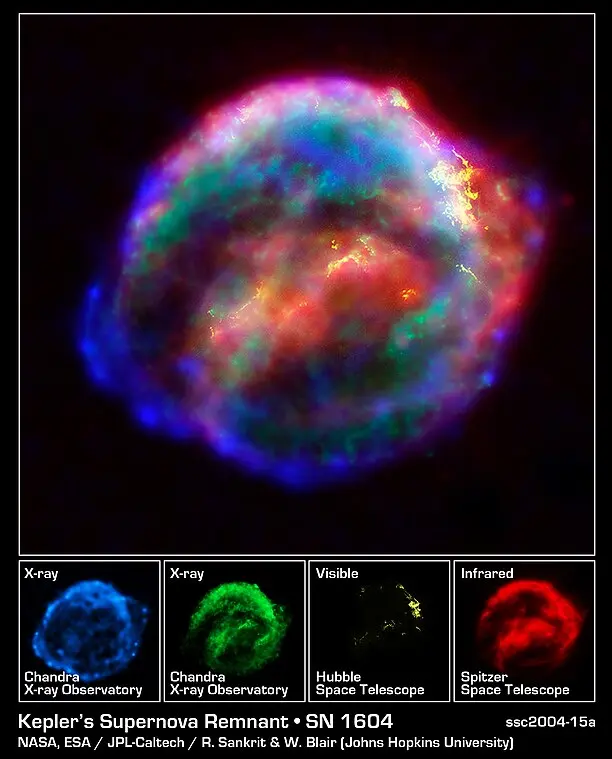
NASA’s three Great Observatories — the Hubble Space Telescope, the Spitzer Space Telescope, and the Chandra X-ray Observatory — joined forces to probe the expanding remains of a supernova, called Kepler’s supernova remnant, first seen 400 years ago by sky watchers, including famous astronomer Johannes Kepler. The combined image unveils a bubble-shaped shroud of gas and dust that is 14 light-years wide and is expanding at 4 million miles per hour (2,000 kilometers per second). Observations from each telescope highlight distinct features of the supernova remnant, a fast-moving shell of iron-rich material from the progenitor star, surrounded by an expanding shock wave that is sweeping up interstellar gas and dust. Each color in this image represents a different region of the electromagnetic spectrum, from X-rays to infrared light. These diverse colors are shown in the panel of photographs below the composite image. The X-ray and infrared data cannot be seen with the human eye. By color-coding those data and combining them with Hubble’s visible-light view, astronomers are presenting a more complete picture of the supernova remnant. Image credit: NASA/ESA/R. Sankrit and W. Blair (Johns Hopkins University)
Location
Kepler’s Supernova lies in the southern part of Ophiuchus, about two fifths of the way from Sabik to Alnasl, the star that marks the spout of the Teapot in the constellation Sagittarius. The remnant appears in the same area of the sky as the bright globular cluster Messier 9. The bright Antares and the Scorpion’s claws can be used for orientation.
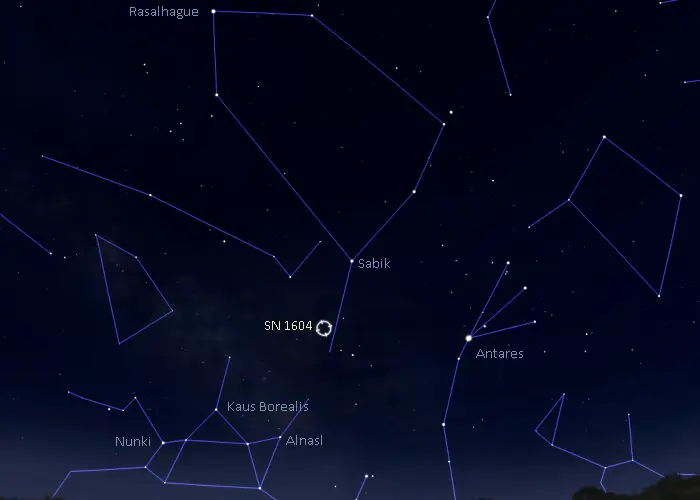
The location of Kepler’s Supernova, image: Stellarium
Kepler’s Supernova – SN 1604
| Constellation | Ophiuchus |
| Right ascension | 17h 30m 42s |
| Declination | −21° 29′ |
| Apparent magnitude (peak) | −2.25 to −2.5 |
| Type | Type Ia |
| Date | October 8-9, 1604 |
| Apparent size | 4 arcminutes |
| Distance | <20,000 light-years (6.1 kiloparsecs) |
| Names and designations | Kepler’s Supernova, Kepler’s Star, Kepler’s Nova, Kepler’s SNR, Kepler SN, SN 1604, Nova Ophiuchi 1604, 3C 358, ESO 588-4, VV’ 208, HR 6515, V843 Oph, SNR G004.5+06.8, PN H 2-12, 2E 3911, 2E 1727.6-2126, 1ES 1727-21.4, GCRV 67121, Haro 3-12, AJG 71, CTA 78, CTB 41, Kes 57, PK 004+06 1, PKS 1727-21, PMN J1730-2129, MRC 1727-214, IRAS 17276-2126, 1RXS J173040.4-212836, VLSS J1730.6-2128, SWIFT J1731.3-2148 |